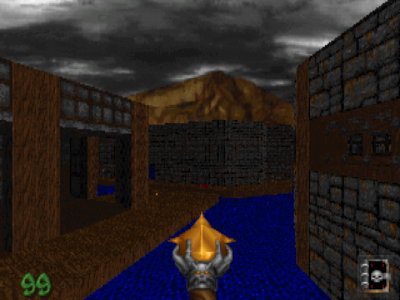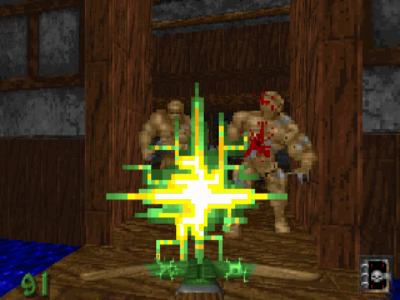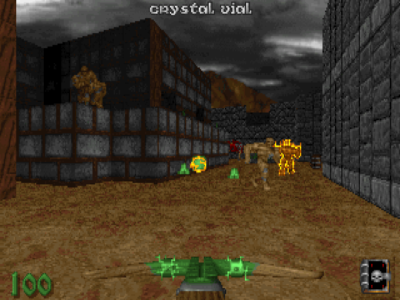
Heretic
Written by: Stoo
Date posted: November 15, 2009
- Genre: Action
- Developed by: Raven
- Published by: id Software
- Year released: 1994
- Our score: 6
So today we’re going back to 1994, kind of the early iron age of first person shooters. Pioneers id software had set the ball rolling a few years earlier with Wolfenstein 3D. Then they followed it up with Doom, which established the next generation in shooter technology. With then-realistic-looking pseudo-3d environments, slick blasting action and multiplayer deathmatch, Doom was wildly popular and hugely influential. Other developers decided they wanted to be a part of this exciting and blood-spattered scene, and set about producing shooters of their own. These games were often referred to as Doom-clones in recognition of the one that had led the charge.
Raven though decided to go about this the simplest way, by licensing the Doom engine itself. They had already worked with iD in the past, using technology somewhere between Doom and Wolf3D to power their Shadowcaster. That one had used a fantasy setting and they took a similar path with Heretic. So Doom’s mars bases are swapped for castles and dungeons. You square off against gargoyle-things, and fight with a range of enchanted magical artifacts. Also you play an elf. Thus the game was nicknamed, not especially flatteringly, “Doom in Tights”.
First up, the environment. Many of the same engine limitations still apply – no slopes in the vertical plane, ie no ramps. Also it can’t do one floor above another. So as was common at the time, levels tend to feel rather abstract. Well sure the general theme of a map might be recognisable as “fortress” or “sewers”. But rooms and corridors don’t seem to serve any obvious purpose and channels of water or toxic waste are there for no reason other than to be a hazard.

I lost a load of screenshots so these ones aren’t the most exciting, sorry.
It still looks decent enough tho by the standard of the day. It’s not all grey tunnels anyway – there are cathedrals, ramparts and open areas. Certainly if you’re up for castles and waterways the aesthetics work pretty well, and it’s even surprisingly attractive on occasion with features like stained glass.
There are a couple of new features implemented on top of the base engine. Perhaps the most useful addition is an inventory of non-weapon items you can store for later use, as opposed to simply activating on pickup. These include healing flasks, temporary powerups for your weapons, and defensive items. Also though you can look up and down. The engine automatically takes care of the vertical component of aiming, just like in Doom, but it still adds a bit of utility and a feeling of realism if you can peer down over a ledge. There’s “flying” too via a powerup, although it’s really just floating, ie letting you move in the vertical axis in the same way as walking. Oddly though no jumping, so you still get the frustrating of being unable to scale a 4 foot tall ledge if you don’t have that powerup.
Aside from those upgrade though, we’re still very much in the usual shooter formula of the time. You blast countless ranks of mummies, gargoyles and skeletons. Along the way you look for coloured keys that open up a further section of the map, then eventually hit an “end level” switch. Then repeat about thirty times. Lots of running and gunning, with a storyline someone jotted on the back of an envelope during lunch at the pub one friday. It’s all very 1994.

Crossbow in the face! Because screengrab and fire were mapped to the same key!
Your weapons meanwhile are essentially “magic guns”. That is, staves and trinkets that shoot brightly coloured energy bolts. What’s more, they pretty closely mirror Doom’s guns. I hasten to add, it’s not that they feel wimpy or useless – the monster-blasting capacity is quite satisfactory. It’s just that given this is a fantasy setting, I might have hoped for a greater emphasis on melee weapons, and maybe some more bows too. (There is a nifty enchanted crossbow, although it’s more or less a shotgun). Some shooty magic sure, just something that’s not so obviously a plasmagun. Well at least the final weapon is a bit more novel, throwing exploding metal spheres. And with the “weapon upgrade” powerup the magi-plasmagun does a cool “rain of red fire” trick.
Decent enemies too. The scrappy gargoyle things you first fight are fragile but surprisingly dangerous as they’re fast, airborne and silent until they start taking swipes at you. Which lead to plenty of “waht?!?” moments being attacked from behind, spinning roudn firing wildly etc. Skeletal knights keep up a steady barrage of thrown axes (why couldn’t we have those?). Mummies look like fairly easily avoided melee-only foes, until later on they occasionally catch fire and shoot homing skulls. And when defeated they split apart as the spirit within escapes.
So overall we have fantasy trappings, some new engine tricks, and a soundtrack that isn’t trying to replicate Slayer via midi. Still, it’s really not far removed from Doom. Its unambitious nature is highlighted in fact by its own sequel Hexen. That one again used the Doom engine but had a more thematically suitable arsenal, threw in some puzzles and introduced hub-based levels. So it came across as feeling more unique and original. Though to be fair perhaps Heretic was churned out quickly to get some cash out of the rising popularity of first person shooters, leaving Raven time to work on the new features for Hexen.

More mummies. Watch out for when they go firey.
Also to be clear, an unambitious game is not necessarily a bad one. Since Doom was a classic, a follower that adheres closely to the formula should be decent too, as long as it doesn’t slip up along the way. Indeed Heretic still provides several evenings of solid blasting fun. There’s still the excitement of circle-strafing around a clutch of monsters, dodging their projectiles and blasting them full of magic fire. Then emerging from the piles of corpses, grabbing the “floating there for no reason” powerups and bracing yourself for the next encounter.
Maybe a touch of nostalgia helps. I eschewed modern source ports and played this in ye olde VGA, enjoying the midi music, digitised chimes and mumbly monster noises. After a stressful day at work and a rotten cold (I never get sick usually, but was overwhelmed by ruthless Canadian germs), I found it a welcome means of unwinding. Oh and it was initially distributed udner the shareware system, which means you can try the first episode (nine levels) for free. There are titles from that generation that were more important for sure, but for a few quid on Steam anyone still with a fondness for those pseudo-3D days can’t go badly wrong.


 Posts
Posts